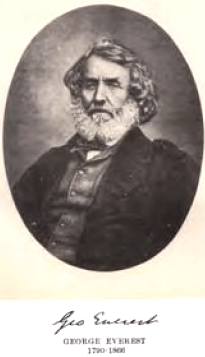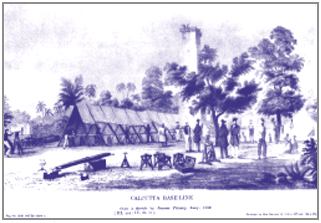Everest returns to India (1830 to 1839)
Oct 2006 | Comments Off on Everest returns to India (1830 to 1839)
|
|
 After his extended sick leave Everest reached India again in October 1830, taking with him various items of equipment that represented the state of the art at that time. In particular was the set of compensating bars and he made the first use of these on the Calcutta baseline in 1831-2. Why Calcutta when that was a very long way from the meridian arc?
During his absence on leave Joseph Olliver had observed a longitudinal series from near Sironj on the Great Arc to within about 100 miles of Calcutta. With his headquarters in Calcutta and the added incentive to try out the new baseline equipment, Everest decided to use his new equipment and to close out this |
|
longitudinal arc at the same time and immediately sought out a likely site.
As soon as the catch-up administrative work that had amassed in his absence was on the way to being cleared he set out to plan this new baseline. It took 45 days and nearly 100 personnel to complete the nearly 34 000 feet. The value calculated through the 671 miles from Sironj agreed with the measured value to 7 ft 11 inches. The base itself was considered to be good to little more than 1 inch.
In late 1832 Everest moved his headquarters from Calcutta to Dehra Dun where it remains to this day. As will be seen later, however, he also established a personal estate in the hills above Mussoorie. By then he was
thinking of a control baseline on the meridian arc and seeking a suitable site near Dehra Dun. However before being able to do that it was necessary to triangulate across the flat Doab region from Agra northwards to Delhi and then on towards Dehra Dun. It was so flat that in one stretch of 160 miles there was only a rise of some 268 feet. It was 1835 when it became possible to measure the Dehra base and complete the meridian chain from Sironj. Measured twice, this base was nearly 39 200 feet long and the repeated measure agreed to 2.4 inches with the first. Thus with the Calcutta and Dehra baselines proved the worth of the compensating bars.
During extended periods Everest was again laid low with illness but struggled onwards both on the Arc and with minor series. He had new instrumentation in the form of two astronomical circles, but these caused some problems. He had a workshop at his Estate in the hills and there spent much time supervising changes to these instruments until he was happy with their operation.

In 1837 he was back on the meridian arc – no doubt his first love and one he intended to see through to completion come what may. The various other series underway at that time were essential to the overall picture very much took a back seat.
Towards the end of 1838, after over 30 years in India – albeit interrupted for sick leaves- Everest felt that he was entitled to some suitable recognition for all the effort he had put into the Survey of India. He had noticed how many military personnel had achieved honours and felt that his achieved outweighed many of them and so he submitted a memorandum in effect asking for the award of a decoration – a CB (Companion of the Order of the Bath) was what he had in mind. At that time he was to be unlucky as in a later similar request.
During all this period there were intermittent bouts of fever and other ailments but he pulled through all of them. At one period he was so ill that he was bled to fainting by the use of 1000 leeches and the application of 30 or more cupping glasses. Both were means of extracting “bad” blood and were, at the time, though to be an appropriate treatment. A cupping glass was a heated vessel that was applied to the skin as an alternative to leeches to draw out blood. Both sound quite barbaric.
|
 |
|
|
JR Smith
|
jim@smith1780.
|
freeserve.co.uk
|
|
|
|
|
|
|
|






 (5.00 out of 5)
(5.00 out of 5)





 (5.00 out of 5)
(5.00 out of 5)





 (5.00 out of 5)
(5.00 out of 5)





 (5.00 out of 5)
(5.00 out of 5)